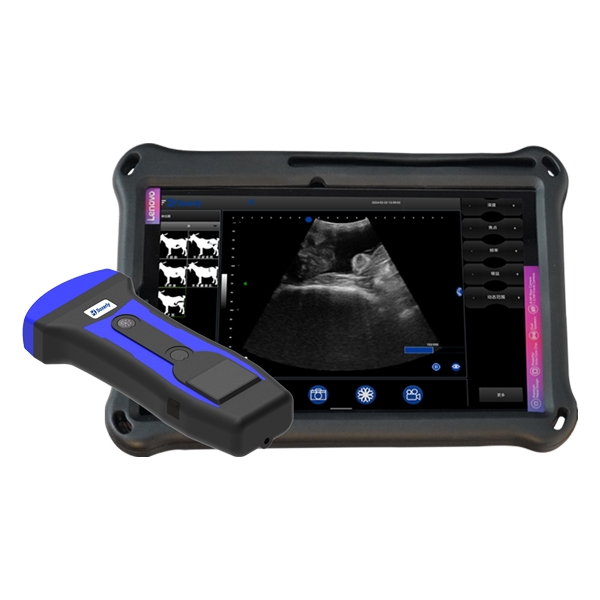Application of B-ultrasound in the diagnosis of pigs. The imaging manifestations and detection methods vary depending on the duration of pregnancy. According to the different stages of fetal development, the entire pregnancy period is divided into three stages: after 26 days of pregnancy, the pig embryo gradually shows the inherent contour of the fetus, including the fetal head, body, and limbs; After 39 days of pregnancy, the fetal bone reflex is enhanced and fetal movement occurs, followed by the gradual appearance of sound shadows in the bones with enhanced reflex; During early pregnancy (before 45 days), the uterine area in front of the bladder should be the main focus of exploration. At this time, the ultrasound imaging of pigs mainly features a complete and regular shape of the gestational sac and fetal body. Mid pregnancy (45-60 days) is the period of fetal bone calcification, during which the proportion of the fetal body to the entire gestational sac gradually increases, the proportion of amniotic fluid decreases, and the fetal bone gradually calcifies completely. Therefore, the imaging presentation is mainly characterized by gradually clear bone images, and it is generally not easy to see the gestational sac and fetal body with regular shapes like in the early stages. At this point, the fetus's liver and stomach can gradually be observed as small circular dark areas located in the middle of the body. These pigs undergo changes in ultrasound images using a B-ultrasound system, which displays the developmental patterns of the fetus in its early stages and provides scientific evidence for identifying stillbirths or other abnormal phenomena. Usually, the determination of stillbirth is based on the condition of the fetus and amniotic fluid, and it may be found that the fetal head tension is weakened, the fetal heartbeat disappears
The internal structure of the abdomen is disordered and unclear, and there are few dark areas of amniotic fluid in the uterine cavity. In the late stage of pregnancy (60 days), fetal bone calcification is complete and the fetal volume is relatively large. Therefore, when pigs use B-ultrasound to explore, the main focus is on observing the longitudinal section of the fetal bone, especially the longitudinal section of the fetal chest cavity, which is more intuitive. During this period, the detection position should gradually move forward, and the detection direction should gradually move forward to adapt to the increase and forward movement of the uterine angle. In the later stages of pregnancy, M-ultrasound should be used to measure fetal heartbeat. As the proportion of amniotic fluid gradually decreases in the later stages of pregnancy, exploration mainly focuses on exploring the fetal body. During this period, it is easy to measure the fetal heartbeat to determine the condition of the fetus. Before delivery, the condition of the fetus can be determined by measuring its heartbeat. Before delivery, the condition of the fetus in the mother's body can be monitored by measuring the number of fetal heartbeats. During pregnancy, the fetal heart rate was measured as 190 beats per minute (on the 20th day of pregnancy) in pigs. It increased to an average of 210 beats per minute from the 21st to the 25th day of pregnancy, remained above 220 beats per minute from the 26th to the 50th day, and may reach 264 beats per minute in some cases. After the 50th day, it gradually slowed down, and after the 100th day, it was about 150 beats per minute, with a faster heart rate than the mother. If the fetal heartbeat is measured to be faster, it can indicate that the fetus is in the mother's body due to hypoxia or other reasons, and needs to be given oxygen or induced labor as soon as possible. If the fetal heartbeat starts to slow down, it indicates that the fetus is entering a state of failure and must be treated as soon as possible. Otherwise, the fetus will die. The fetal heartbeat can be determined by using a B-ultrasound machine to determine whether the prolongation of pregnancy is normal







